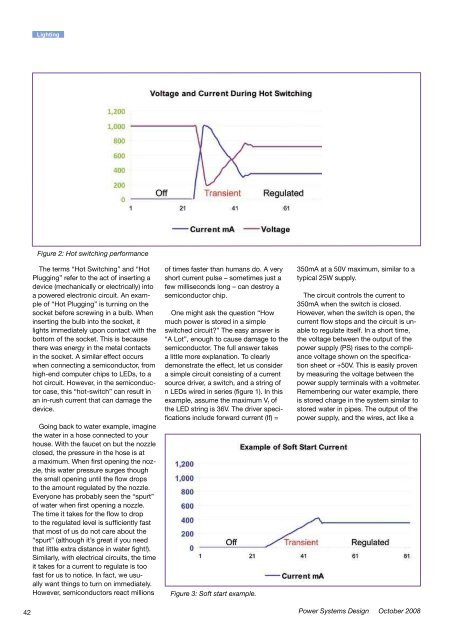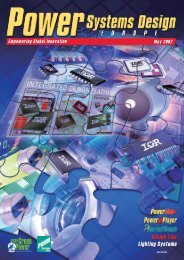Powering Freight & Transportation - Power Systems Design
Powering Freight & Transportation - Power Systems Design
Powering Freight & Transportation - Power Systems Design
You also want an ePaper? Increase the reach of your titles
YUMPU automatically turns print PDFs into web optimized ePapers that Google loves.
42<br />
Lighting<br />
Figure 2: Hot switching performance<br />
The terms “Hot Switching” and “Hot<br />
Plugging” refer to the act of inserting a<br />
device (mechanically or electrically) into<br />
a powered electronic circuit. An example<br />
of “Hot Plugging” is turning on the<br />
socket before screwing in a bulb. When<br />
inserting the bulb into the socket, it<br />
lights immediately upon contact with the<br />
bottom of the socket. This is because<br />
there was energy in the metal contacts<br />
in the socket. A similar effect occurs<br />
when connecting a semiconductor, from<br />
high-end computer chips to LEDs, to a<br />
hot circuit. However, in the semiconductor<br />
case, this “hot-switch” can result in<br />
an in-rush current that can damage the<br />
device.<br />
Going back to water example, imagine<br />
the water in a hose connected to your<br />
house. With the faucet on but the nozzle<br />
closed, the pressure in the hose is at<br />
a maximum. When first opening the nozzle,<br />
this water pressure surges though<br />
the small opening until the flow drops<br />
to the amount regulated by the nozzle.<br />
Everyone has probably seen the “spurt”<br />
of water when first opening a nozzle.<br />
The time it takes for the flow to drop<br />
to the regulated level is sufficiently fast<br />
that most of us do not care about the<br />
“spurt” (although it’s great if you need<br />
that little extra distance in water fight!).<br />
Similarly, with electrical circuits, the time<br />
it takes for a current to regulate is too<br />
fast for us to notice. In fact, we usually<br />
want things to turn on immediately.<br />
However, semiconductors react millions<br />
of times faster than humans do. A very<br />
short current pulse – sometimes just a<br />
few milliseconds long – can destroy a<br />
semiconductor chip.<br />
One might ask the question “How<br />
much power is stored in a simple<br />
switched circuit?” The easy answer is<br />
“A Lot”, enough to cause damage to the<br />
semiconductor. The full answer takes<br />
a little more explanation. To clearly<br />
demonstrate the effect, let us consider<br />
a simple circuit consisting of a current<br />
source driver, a switch, and a string of<br />
n LEDs wired in series (figure 1). In this<br />
example, assume the maximum V f of<br />
the LED string is 36V. The driver specifications<br />
include forward current (If) =<br />
Figure 3: Soft start example.<br />
350mA at a 50V maximum, similar to a<br />
typical 25W supply.<br />
The circuit controls the current to<br />
350mA when the switch is closed.<br />
However, when the switch is open, the<br />
current flow stops and the circuit is unable<br />
to regulate itself. In a short time,<br />
the voltage between the output of the<br />
power supply (PS) rises to the compliance<br />
voltage shown on the specification<br />
sheet or +50V. This is easily proven<br />
by measuring the voltage between the<br />
power supply terminals with a voltmeter.<br />
Remembering our water example, there<br />
is stored charge in the system similar to<br />
stored water in pipes. The output of the<br />
power supply, and the wires, act like a<br />
<strong>Power</strong> <strong>Systems</strong> <strong>Design</strong> October 2008<br />
very large capacitor by storing charge<br />
analogous to the manner pipes and the<br />
hose store water. When the switch is<br />
closed, this charge flows rapidly through<br />
the circuit until the power supply begins<br />
to self-regulate. However, the total<br />
stored charge in the wires may be sufficient<br />
to destroy a semiconductor such<br />
as an LED.<br />
Preventing the destructive current<br />
surge is a matter of design. The simple<br />
statement of “No Hot Switching”, “Soft<br />
Start”, or “Cold Switched” is sufficient<br />
to assure no current surge. To a lay person<br />
the difference between the surging<br />
current of a hot-switched unit and a unit<br />
with a soft start is best seen in a chart.<br />
The chart plots current (on the left y-axis)<br />
and voltage (on the right axis) versus<br />
time. There are three points of interest:<br />
before the device is switched on; during<br />
the time it takes the power supply to<br />
regulate (usually a few milliseconds);<br />
and, after the current regulates.<br />
By using Ohm’s Law, where the Volt-<br />
<strong>Power</strong>Pack <strong>Power</strong>Pack<br />
www.powersystemsdesign.com<br />
age is equal to the current multiplied by<br />
the resistance or V = IR, we can calculate<br />
Current through the LED. From the<br />
graph, it is easy to see how the voltage<br />
transient behavior injects a large current<br />
spike (in this case, three times the design<br />
value) into the LED. These current<br />
spikes can cause permanent damage to<br />
any semiconductor (ICs, microprocessors,<br />
and LEDs too).<br />
By specifying a soft start, these ugly<br />
current spikes can be easily avoided.<br />
A soft start circuit assures the drive<br />
wires are at zero volts when the switch<br />
is open. With the closing of the switch,<br />
the current rises from zero to the design<br />
parameters without the current spike<br />
shown before. This is analogous to the<br />
leaving the nozzle on the hose open<br />
while turning on the water at the faucet.<br />
It takes a little time for water to reach<br />
the nozzle, and when it does, the flow<br />
rises to the desired amount.<br />
We have shown how improperly<br />
specified driver circuits can and will<br />
A <strong>Power</strong>ful<br />
Combination<br />
<strong>Power</strong>Pack and e<strong>Power</strong>Pack is a new<br />
advertising program in print and online designed to<br />
promote your company’s new products, seminars,<br />
and announcements while driving traffi c to your<br />
company’s website.<br />
Advertisers receive a 100 word listing, plus product<br />
photo and url link in print to 20, 357+ subscribers<br />
of <strong>Power</strong> <strong>Systems</strong> <strong>Design</strong>’s magazine and online<br />
through e<strong>Power</strong>Pack e-newsletter which is delivered<br />
every month to an audience of 24,000 power electronic<br />
engineers in Pan Europe and 32,000 power<br />
design engineers in North America. To participate<br />
contact: Julia@powersystemsdesign.com<br />
<strong>Power</strong> <strong>Systems</strong> <strong>Design</strong><br />
<strong>Power</strong> <strong>Systems</strong> <strong>Design</strong> <strong>Power</strong>Pack<br />
Lighting<br />
introduce semiconductor damaging<br />
current spikes. Properly specifying the<br />
driver assures effective current regulation.<br />
<strong>Design</strong>ing for a “Soft Start” is not<br />
an unusual request, hard to do, or more<br />
expensive. A search of National Semiconductor’s<br />
WEBBENCH ® tools site<br />
revealed they have over 200 products in<br />
their catalog that, by design, are “Soft<br />
Starting” ICs to drive LEDs and other<br />
semiconductors. Further, with WEB-<br />
BENCH ® one can immediately download<br />
a reference design with complete BOM<br />
based on your chosen Luxeon LED and<br />
operating parameters.<br />
Other driver manufacturers also sell<br />
driver electronics that are specifically<br />
designed to work with high-power LEDs<br />
such as the LUXEON I, LUXEON III,<br />
LUXEON V, LUXEON K2, LUXEON Rebel<br />
and LUXEON K2 with TFFC, and “Soft<br />
Start” is only one driver characteristic of<br />
interest. But it is a critical one.<br />
www.philipslumileds.com<br />
<strong>Power</strong> <strong>Systems</strong> <strong>Design</strong><br />
PowefulComboAd.indd 1 3/13/08 5:58:47 PM<br />
43









